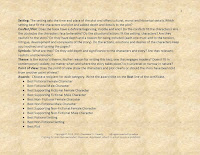This morning, I was reading The Washington Post's Book section and saw that The Martian by Andy Weir, The Revenant by Michael Punke and Brooklyn by Colm Toibin all made the top paperback book sales for last week. Why did these titles ring an, "Aha!" bell in my not-quite-caffeinated-enough brain? Because just this past week, I read their titles on the Academy Award nominations list for Best Motion Picture of 2015.
Other books turned into movies that made the nominations list
in that same category as well as others -some in multiple categories- are The Big Short by Michael Lewis, Room by
Emma Donahue, Carol - based on The Price of Salt by Patricia Highsmith, The Danish Girl by David Ebershoff, Trumbo by Bruce Cook, 45 Years - based
on In Another Country by David Constantine, and Fifty Shades of Grey by E.L. James.
Although many of these books will never be read in the secondary classrooms, some might. The point is- without the original books, these movies never would have been made. This thought made me wonder, "What about literary awards since so many films begin with an already published fiction or non-fiction piece?"
Students would select their choices for The Academic Awards for Literature from books they either studied as a class or read independently. It doesn't matter if the book they choose has never been made into a film. They have read enough novels and narrative nonfiction and viewed enough movies to form opinions as to which ones earn the label of the Best.
Would they vote for Mockingjay by Suzanne Collins? The Stranger by Albert Camus? One Flew Over the Cuckoo's Nest by Ken Kesey? The Great Gatsby by F.Scott Fitzgerald, or one of many other solid choices?

The categories for the awards are based on the elements of literature - Characters, Settings, Plot/Conflicts, Symbols, themes and Point of View.
To complete this lesson, students are required to
1. write the category
title and their choice for the Best in that category in the given spaces on the
certificate.
2. explain
and support each choice in a paragraph on the awards certificate, following
the points under Writing Criteria.
3. make sure that their writing specifically addresses the criteria for each category.
4. defend one or more of their selections during a class discussion.
3. make sure that their writing specifically addresses the criteria for each category.
4. defend one or more of their selections during a class discussion.
The
criteria for Fiction and Non-fiction offers students points to ponder about
each element of literature as they consider how to explain the who, what,
where, when and why behind their choices.
Example:
Characters (Types of characters are in the parentheses): Does the character
grow and change (dynamic), show different sides to his/her personality (round),
stay one-dimensional in his/her personality (flat) or show no mental/emotional
and/or spiritual growth (static)? Is the character: major, minor, the
protagonist or the antagonist? Are the characters believable and or
sympathetic? Do you care what happens to them?
After they choose their recipients for each award students are to fill in the certificates. Here are six of the twenty categories
•Best Fictional Female Character
•Best Fictional Male Character
•Best Supporting Fictional Female Character
•Best Supporting Fictional Male Character
•Best Non- Fictional Female Character
•Best Non-Fictional Male Character
In their explanatory paragraphs, students must state the award recipient as well as the title and author of the text. To defend their choices, the explanations must include three examples along with supporting details that justify each choice and that add clarity to the reasoning behind it.
The Teacher Notes page lists the Common Core
Standards that pertain to this activity as well as the Bloom's Taxonomy terms
students will utilize.
Download this timely activity from https://www.teacherspayteachers.com/Product/Reading-Analysis-Activity-Presenting-the-Academic-Awards-for-Literature-523512 ($2.50)
For another engaging activity for books that have been turned into movies, try - https://www.teacherspayteachers.com/Product/Literature-Analysis-Activity-Comparing-Books-and-Movies-32844 ($1.25)
These lessons mesh reading, writing and viewing into activities that are guaranteed to ignite lively discussions where students support their opinions with facts and details. Who knows- someday one of their book choices might be turned into a movie, and they will hear their choice introduced during the 20_ _ Academy Awards with the words, "And the winner is...".
Enjoy a Teach It Now Day Every Day.








No comments:
Post a Comment